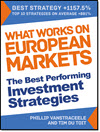If you manage your own investments, this article shows you why sticking to one fixed strategy can quietly hurt your returns - and what to do about it.
You will learn how smart investors like James O’Shaughnessy adapted their strategies based on real-world data, not gut feelings. Most importantly, you will see how to spot when your strategy needs an upgrade, and how to make changes without losing focus. This will help you stay confident and flexible, even when markets change.
It is a short, practical guide to help you evolve as a better, more successful investor.
Estimated Reading Time: 4 minutes
When you’re investing your own money, having a solid investment strategy is the most important thing that will determine your success. It makes it easy for you to make decisions, manage risk, and will give you the best chance to reach your long-term goals.
But here’s the thing: no strategy should stay the same forever. Stock markets are always changing, and your strategy needs to change with it. Updating your strategy based on the latest data can keep it effective and help you stay on track to reach your financial goals.
Why You Need to Evolve Your Strategy
Sticking to your original strategy might feel like the right thing to do, but it can hurt you in the long run. The market changes over time due to things like economic shifts, new technologies, and changes in investor behaviour.
A strategy that worked great a few years ago might not perform as well today. For example, if you’ve been focusing on companies with high tangible assets, (cheap in terms of price to book) you will miss out as more companies grow through intangible assets like brand value or software.
This doesn’t mean you should constantly change your approach, but you should be open to adjusting your strategy when needed. By doing so, you can make sure it keeps working as the market changes.
How James O’Shaughnessy Evolved His Strategy
James O’Shaughnessy is a well-known name in investing. He is the author of the outstanding book What Works on Wall Street. And he is famous for using data and research to guide his strategies.
Over the years, he hasn’t been afraid to change his approach when the data supported it. For example, he originally used the Price-to-Sales ratio as a key value metric. But as his research progressed, he found that using a combination of factors, like Price-to-Earnings and EBIT to Enterprise Value, gave better results.
By creating a composite metric that includes several factors, he was able to get a clearer picture of a company’s value. This change helped improve the performance of his strategy, especially in different market conditions.
Based on further testing he also found that even though Price to Book worked great some of the time it also underperformed for long periods of time.
Based on this research we developed two composite valuation ratios that exclude Price to Book. You can read about them here:
His willingness to adapt based on new information shows the importance of being flexible in your investing approach. You can read more about his composite valuation indicators here:
Conclusion
Evolving your investment strategy is important if you want to stay successful in the stock market. As the market changes, so should your approach. James O’Shaughnessy’s experience shows how important it is to adjust your strategy based on solid research and data.
By balancing traditional strategies that worked over long periods of time with new ideas, you can ensure your strategy remains effective. Stay open to change, and let data guide your decisions to update your strategy.
Click here to start using the Quant Value Composite in your stock screens NOW! - Click here
FREQUENTLY ASKED QUESTIONS
1. How do I know when it is time to change my investment strategy?
If your returns have slowed or your stocks are underperforming the market, it is a sign to look deeper. But more importantly, if the data behind your strategy is outdated or no longer reflects how the market works, that is your cue. A good rule: review your strategy once a year and compare it against new research.
2. What if my current strategy used to work, but now it doesn't?
That happens to every investor. The stock market evolves. A once-winning strategy can underperform for years. Do not throw it out. Update it. James O’Shaughnessy did this by testing new factors and creating stronger composite scores like Value Composite One and Two. You can do the same by learning and adapting based on data.
3. I still use Price-to-Book. Is that a problem?
Not always, but it can be. Price-to-Book works well when companies had a lot of physical assets. Today, many companies grow through software, brand, or people - things you cannot measure with book value. This is why some strategies now avoid it and use metrics like Qi Value or Quant Value Composite instead.
4. How can I update my strategy without starting over?
Start small. Keep the structure, but adjust the details. For example, replace one outdated ratio with a better one based on new research. Backtest the new version using historical data. If it performs better, update your whole process. Always change based on proof, not gut feelings.
5. How often should I tweak my strategy?
Rarely. Constant tweaking leads to poor decisions - also called data fitting. Review once a year at most. Only make changes when the data clearly shows a better option. Like O’Shaughnessy, follow the facts, not your feelings.
6. What is a composite value score, and why should I use one?
A composite score blends several ratios into one score. Instead of picking stocks based on just Price-to-Earnings or Price-to-Sales, you combine multiple metrics. This gives a more balanced view and helps avoid the risk of one weak factor hurting your results. It is like looking at the whole puzzle, not just one piece.
7. Can updating my strategy really improve my long-term results?
Yes. The best investors evolve. O’Shaughnessy improved his results by switching to a multi-factor model. You can do the same. A better strategy helps you pick stronger companies, avoid big losses, and grow your wealth with more confidence.
Click here to start using the Quant Value Composite in your stock screens NOW! - Click here


